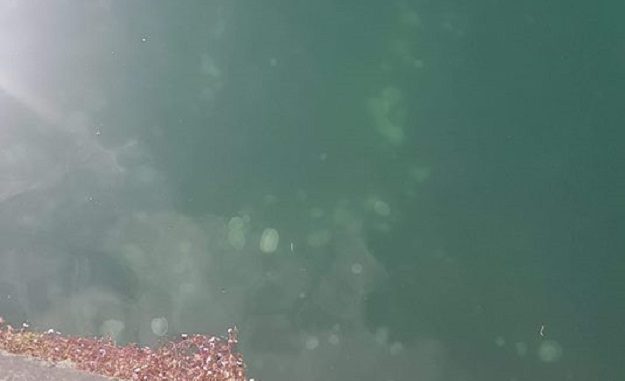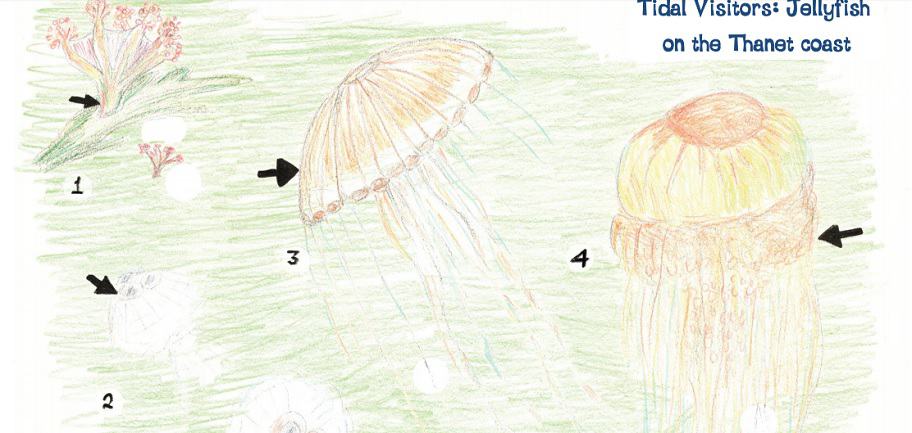
Scores of jellyfish massed at Ramsgate Harbour have been caught on camera by care worker Billie Rachel.
The Ramsgate resident took the snaps yesterday (June 8) after being surprised by the sheer amount of the creatures gathered in one place.
The gathering is normal and has been prompted by warmer weather giving the jellyfish the opportunity to feed.
Thanet Coast Warden Tony Ovenden said: “It is that time of year when the warmer weather accelerates the growth of algae and plankton of which the jelly fish feed on.
“Compared to the open sea Ramsgate harbour is settled with little movement . This allows the jelly fish to congregate and feed.”
Crystal jellyfish amongst the rockpool finds at
Walpole Bay #Margate
on #WorldOceanDay
on the #ThanetCoast pic.twitter.com/aw9dsq9AUt— Thanet Coast(NEKMPA) (@ThanetCoastProj) June 8, 2018
Several species of jellyfish are occasionally spotted on the Thanet coast – although people are warned not to touch even stranded specimens as their sting can be painful.
Species found in isle waters are generally:

1. Stalked Jellyfish
Very small and branched, looks a bit like a fluted wine glass. Nearly always attached to seaweed or rocks.
2. Moon Jellyfish
These are extremely common. Look for the four conspicuous blue circles on the body. Usually found as small specimens washed ashore, but can grow up to 30cms or more. Can give a mild sting but usually totally harmless.
3. Compass Jellyfish
Easily recognised by the lines radiating from the centre of the body. Usually washed up on the shore broken up . Body can be a dinner plate width with tentacles a metre or more trailing behind. There are occasional seasonal swarms. sting unwary swimmers.
4.Lion’s Mane Jellyfish
Rare. Specimens found stranded are usually small, less than 10 cms across the body but they have been known to reach sizes of 60cms or more, They look very similar to a straggly brownish/yellow rug, hence the popular name, with the tentacles trailing many metres behind. Dangerous to swimmers as the sting can be extremely painful.
Portuguese man-of-war

This is not a jellyfish, but a floating colony of organisms dependent on one another for survival. These do exist in UK waters. The sting is extremely painful for humans and can be fatal in rare circumstances.
If you get stung:
Most jellyfish stings are mild and don’t require treatment, or you can treat them yourself. However, dial 999 if there are severe symptoms, such as difficulty breathing or chest pain, or if a large or sensitive area of the body has been stung.
Someone stung by a jellyfish should be treated out of the water – Any remaining tentacles should be removed using tweezers or a clean stick (wear gloves if they’re available). Applying an ice pack to the affected area helps to reduce pain and inflammation.
Vinegar is no longer recommended for treating jellyfish stings, because it may make things worse, by activating unfired stinging cells. The use of other substances, such as alcohol and baking soda, should also be avoided. Ignore any advice you may have heard about urinating on the sting. It’s unlikely to help and may make the situation worse.
Use a razor blade, credit card or shell to remove any nematocysts (small poisonous sacs) that are stuck to the skin. It may help to apply a small amount of shaving cream to the affected area first.
Aftercare: Any pain and swelling can be treated with painkillers, such as paracetamol and ibuprofen. Portuguese man-of-war stings can be treated in a similar way to jellyfish stings. After carefully removing any remaining tentacles from the skin, thoroughly wash the affected area with seawater (not fresh water).
Afterwards, soak the area in hot water to ease the pain. Pain from a Portuguese man-of-war sting usually lasts about 15-20 minutes. Seek immediate medical assistance if you experience severe, lasting pain, or if the affected area becomes infected.
Information with thanks to the Thanet Coast Project



